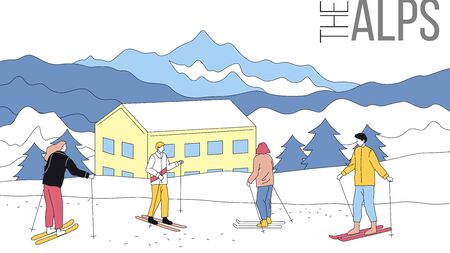1. Understanding Vision Impairments and Trekking
Exploring the great outdoors is a beloved activity across the United States, but for people with vision impairments, trekking can present unique challenges. Understanding the different types of vision impairments and how they affect outdoor experiences is key to making US parks more accessible and enjoyable for everyone.
Types of Vision Impairments
Vision impairments come in many forms, each affecting people in distinct ways when it comes to navigating trails, reading signs, or recognizing natural obstacles. Here’s a quick overview:
| Type of Vision Impairment | Description | Potential Trekking Challenges |
|---|---|---|
| Low Vision | Partial sight, not correctable by standard glasses or contacts | Difficulties with depth perception, spotting trail markers, or uneven terrain |
| Blindness | No usable vision; may rely entirely on other senses or assistive devices | Navigating trails independently, avoiding obstacles, staying on path |
| Color Blindness | Trouble distinguishing certain colors, commonly reds and greens | Missing color-coded signs or trail blazes; difficulty identifying some hazards |
| Peripheral Vision Loss (Tunnel Vision) | Loss of side vision while central vision remains clear | Bumping into objects outside the central field; missing wildlife or changes in trail width |
| Central Vision Loss (Macular Degeneration) | Blurry or blank spots in the center of vision; peripheral vision remains intact | Trouble reading maps or fine print on information boards; identifying small trail details |
How Vision Impairments Affect Trekking in US Parks
The impact of these conditions varies depending on the individual and their chosen activity. For example, those with low vision may benefit from high-contrast signage and tactile paths, while those who are blind might use guide dogs or trek with companions. US parks are increasingly aware of these needs and are working to provide resources like audio guides, braille maps, and accessible trails designed with sensory cues.
The Importance of Inclusive Design in Outdoor Spaces
When park planners understand the diverse experiences of visitors with vision impairments, they can design spaces that welcome everyone. From smooth surfaces to well-marked pathways and clear wayfinding systems, thoughtful features make a real difference for trekkers with all levels of sight.
2. Legal Protections and Accessibility Standards in US Parks
Understanding the ADA: Your Rights as a Visitor
The Americans with Disabilities Act (ADA) is a federal law that protects the rights of people with disabilities, including those with vision impairments. The ADA requires all public spaces—including national and state parks—to provide accessible facilities and services. This means park staff must make reasonable accommodations to ensure everyone can enjoy outdoor recreation safely and independently.
Park Policies for Visitors with Vision Impairments
Most US parks have specific policies to support visitors who are blind or have low vision. These include accessible trails, tactile maps, audio guides, Braille signage, and trained staff ready to help. Some parks also allow service animals on all trails, even where pets are not typically permitted. It’s always a good idea to call ahead and check what resources your chosen park offers.
What Accessibility Features Can You Expect?
| Accessibility Feature | Description | Where to Find It |
|---|---|---|
| Braille & Tactile Maps | Raised or Braille trail maps for orientation and navigation | Visitor centers, information kiosks |
| Audio Guides & Apps | Recorded descriptions of trails and features; some parks offer free mobile apps | Official park websites, visitor centers |
| Braille Signage | Braille text on signs for key locations like restrooms or trailheads | Main entrances, visitor centers, accessible trails |
| Accessible Trails | Paved or packed-surface paths with handrails and edge markers for easy navigation | Designated accessible routes in most major parks |
| Service Animal Access | Full access for guide dogs and other service animals on all park grounds | All areas of the park open to visitors |
| Trained Staff Assistance | Rangers and volunteers trained in assisting visitors with disabilities | On-site at visitor centers, ranger stations, guided tours |
Tips for Planning Your Visit
- Contact the Park Ahead: Ask about specific accessibility features and request any special accommodations you might need.
- Check Park Websites: Many parks provide detailed accessibility information online, including trail conditions and available resources.
- Travel with a Companion: While many parks are equipped for solo adventurers, having a friend or family member can enhance safety and enjoyment.
- Bring Assistive Devices: If you use a white cane, GPS device, or smartphone app for navigation, make sure it’s fully charged and ready to go.
- Know Your Rights: Park staff are required by law to assist you—don’t hesitate to ask for help!

3. Adaptive Trail Features and Assistive Technologies
Exploring US parks with vision impairments is becoming easier thanks to a range of adaptive features and assistive technologies. These advancements are making outdoor adventures more accessible, safe, and enjoyable for everyone. Here’s a look at some of the key tools and features you’ll find in many US parks:
Tactile Trail Guides
Tactile trail guides provide hands-on navigation support for hikers with vision impairments. These guides use raised maps or textured surfaces that can be felt, helping users understand trail routes, landmarks, and important stops along the way. They’re often installed at trailheads or key points along accessible trails.
Audio Wayfinding Tools
Many parks now offer audio wayfinding systems that give spoken directions and information about trails. These can come as smartphone apps, portable devices, or fixed stations placed along the path. Audio descriptions may include details about the terrain, upcoming turns, rest areas, and notable features.
Examples of Audio Wayfinding Tools:
| Tool | Description | Where to Find |
|---|---|---|
| Aira App | Live assistance via smartphone for real-time navigation. | Available nationwide in participating parks |
| Braille Audio Trails | Stationary devices that play pre-recorded trail information. | Installed on select accessible trails |
Accessible Signage
Inclusive signage plays a big part in making trails user-friendly for all visitors. Signs may include braille text, high-contrast colors, large fonts, and tactile symbols. These signs help with orientation, provide safety tips, and point out significant features along the route.
Other Assistive Technologies
Parks are embracing new technologies to further enhance accessibility:
- GPS-based Apps: Some apps guide users through voice prompts and vibration feedback specific to park trails.
- Trail Beacons: Small electronic beacons send signals to smartphones or handheld receivers with location-based updates or alerts.
- Adaptive Mobility Devices: All-terrain wheelchairs or hiking poles designed for various abilities are sometimes available for loan at visitor centers.
Accessibility Feature Comparison Table
| Feature | Main Benefit | Typical Location in Parks |
|---|---|---|
| Tactile Trail Guides | Sensory mapping for orientation and route-finding | Trailheads, key intersections |
| Audio Wayfinding Tools | Real-time spoken directions and info | Paved/accessible trail routes, park apps |
| Braille & High-Contrast Signage | Easier reading for low vision or blind hikers | Main paths, entrances, scenic spots |
| Trail Beacons & GPS Apps | Location-specific alerts and guidance | Select modernized park trails |
| Adaptive Mobility Devices (loaned) | Easier movement on challenging terrain for all abilities | Pilot programs at visitor centers in some national parks |
These adaptive features and technologies are helping break down barriers so that everyone can enjoy America’s beautiful parks—no matter their level of vision.
4. Accessible Trails and Popular Inclusive Parks
Exploring the great outdoors shouldn’t be limited by vision impairments, and many US parks have made significant strides in creating accessible experiences for everyone. Across the country, several national and state parks offer specially designed trails and facilities to support visitors with vision impairments. Here’s a look at some major US parks and specific trails that stand out for their accessibility.
Major US Parks with Vision-Impaired Friendly Features
| Park Name | Location | Accessible Features |
|---|---|---|
| Yellowstone National Park | Wyoming, Montana, Idaho | Braille and tactile maps, audio-described exhibits, accessible boardwalks at popular geysers like Old Faithful |
| Grand Canyon National Park | Arizona | Braille guides, shuttle buses with audio announcements, rim trails with tactile guide rails |
| Yosemite National Park | California | Braille interpretive signs, audio tours, accessible paved trails such as Lower Yosemite Falls Trail |
| Great Smoky Mountains National Park | Tennessee, North Carolina | Sensory-friendly nature trails, large print materials, visitor centers with audio programs |
| Everglades National Park | Florida | Tactile displays at visitor centers, boardwalks with railings and clear markings, ranger-led accessible tours |
Popular Accessible Trails for Vision-Impaired Trekkers
- The Freedom Trail (Boston National Historical Park, MA): This famous urban trail offers tactile markers along the path and audio guides available through park services.
- Muir Woods Main Trail (Muir Woods National Monument, CA): Paved paths with tactile guide ropes and Braille signage help make this redwood forest accessible.
- Braille Trail (Watson Lake Park, CO): A loop trail specifically designed for people with visual impairments; features rope guides and interpretive Braille signs throughout the route.
- Senses Trail (Great Smoky Mountains National Park, TN/NC): This short nature trail is filled with interactive sensory stations for touch and sound experiences.
- Cuyahoga Valley Towpath Trail (Cuyahoga Valley National Park, OH): This multi-use path has sections that are flat and wide, with wayfinding tools such as tactile maps at visitor centers.
What Makes a Trail Accessible?
An accessible trail typically includes:
- Paved or firm surfaces free of obstacles
- Tactile guide ropes or edges to assist navigation by touch or cane use
- Braille or large-print informational signage along the route
- Audio descriptions or mobile app guides to provide information about surroundings and history
- Rest areas with benches and shade along the way for comfort breaks
Plan Ahead: Contact Visitor Centers for Resources
If you’re planning a trip to any US park, it’s a good idea to contact the park’s visitor center ahead of time. Many parks offer downloadable guides in Braille or large print, arrange guided tours for small groups with special needs, or loan out assistive devices like portable audio guides. With a little preparation and knowledge of what’s available, trekking in America’s beautiful parks can be safe, fun, and inclusive for all adventurers.
5. Guide Programs and Community Resources
For trekkers with vision impairments, access to supportive guide programs and community resources can make all the difference when exploring US parks. Many parks and organizations are dedicated to making outdoor adventures more accessible for everyone, offering a variety of services and partnerships tailored to individual needs.
Park-Provided Guide Services
Some national and state parks in the US offer special guide services for visitors with vision impairments. These may include:
- Ranger-led hikes: Trained park rangers lead small group walks, providing detailed descriptions of surroundings and helping navigate trails safely.
- Tactile maps and audio guides: Parks such as Yellowstone and Grand Canyon provide tactile trail maps and audio descriptions to enhance the hiking experience.
- Advance booking support: Many parks encourage visitors to contact them ahead of time to arrange for special assistance or guided tours.
Examples of Parks with Guide Services
| Park Name | Guide Services Offered | Contact Info |
|---|---|---|
| Yosemite National Park | Ranger-led hikes, tactile maps, assistive listening devices | (209) 372-0200 |
| Grand Canyon National Park | Audio guides, staff assistance on request | (928) 638-7888 |
| Yellowstone National Park | Tactile maps, ranger programs for accessibility needs | (307) 344-7381 |
Volunteer Programs in the Parks
A number of parks have volunteer programs specifically designed to assist visitors with vision impairments. Volunteers are often trained by park staff or through local non-profit organizations. These volunteers can serve as sighted guides, provide verbal information about surroundings, and help with logistics during treks.
- Sighted Guide Assistance: Volunteers accompany individuals or groups on hikes, ensuring safety and offering detailed descriptions of scenery.
- Group Hikes: Some parks organize accessible group hikes where volunteers join in to support trekkers with various needs.
- Visitor Center Help: At many visitor centers, volunteers are available to answer questions and provide orientation for accessible routes.
Partnerships with Specialized Organizations
Parks across the US often partner with organizations that specialize in supporting people with vision impairments. These collaborations help improve accessibility and ensure that specialized resources are available for those who need them.
Main Partner Organizations and Their Roles
| Organization Name | Main Support Provided | Website/Contact |
|---|---|---|
| The American Council of the Blind (ACB) | Advocacy, accessible travel resources, group outings in parks | acb.org |
| Lighthouse for the Blind | Trekking events, adaptive skills training, volunteer guides | lighthouse-sf.org |
| American Hiking Society (AHS) | Trail accessibility initiatives, inclusive volunteer events | americanhiking.org |
How to Access These Resources?
- Email or call ahead: Most parks recommend contacting their accessibility coordinator or visitor center before your trip to discuss your needs.
- Check park websites: Look for sections labeled “Accessibility” or “Special Needs Services” for detailed information on available resources.
- Connect with partner organizations: Reach out to specialized organizations which may host group trips or offer advice specific to your destination.
Your Experience Matters!
If you have feedback or suggestions about accessibility in any US park, don’t hesitate to share your experience with park management or advocacy groups. Your input helps create a better trekking environment for everyone.
6. Planning a Trek: Tips and Recommendations
Packing Essentials for Vision-Impaired Trekkers
Packing smart is key for a safe and enjoyable trek, especially for those with vision impairments. Here’s a handy table to help you prepare:
| Item | Purpose | Tips |
|---|---|---|
| White Cane or Trekking Poles | Navigation & Stability | Consider foldable models for easy carrying |
| High-Contrast Clothing | Visibility for Group Safety | Bright colors make you easier to spot on trails |
| Tactile Maps/GPS Devices | Orientation | Download accessible trail maps before heading out |
| Labeled Containers/Bags | Organized Packing | Braille labels or tactile markers help identify items quickly |
| First Aid Kit with Large Print Instructions | Emergency Preparedness | Include basic supplies and medication in easy-to-open containers |
| Portable Charger/Extra Batteries | Device Readiness | Keep assistive tech powered up at all times |
| Sunscreen & Bug Spray (Easy-Open) | Outdoor Protection | Select bottles with tactile markings or rubber bands for identification |
| ID & Emergency Contact Info (Braille/Large Print) | Safety Documentation | Keep in an accessible pouch on your person at all times |
Communication Strategies on the Trail
- Trekking with a Guide or Friend: Establish clear verbal cues before starting. For example, use “stop,” “step up,” or “branch ahead” so everyone stays on the same page.
- Using Technology: Smartphone apps like Be My Eyes or Aira connect you with sighted assistants who can provide real-time navigation help through your phone camera.
- Tactile Signals: Develop gentle tap signals on the arm or shoulder as non-verbal communication methods when hiking close together.
Packing List Quick Reference Table for Safety and Comfort:
| Packing Category | Main Items to Include |
|---|---|
| Sensory Aids | Braille compass, talking GPS, magnifiers |
| Nourishment | Labeled water bottle, snacks in tactile bags |
| Shelter & Weather Gear | Poncho, hat, gloves, weather radio |
Safety Considerations Specific to US Parks
- Trail Selection: Choose trails designated as accessible by the National Park Service—these often have smoother surfaces, railings, and braille signage.
- Trek Registration: Check if the park offers registration for visitors with disabilities; this can help staff provide extra support if needed.
- Pace Yourself: Plan shorter hikes at first and build up based on comfort and confidence levels.
- Weather Alerts: Sign up for local park alerts to stay updated on changing conditions that may affect trail accessibility.
Your Next Steps Before Hitting the Trail:
- Create a detailed checklist using the tables above so you don’t forget anything important.
- If trekking solo, let someone know your route and estimated return time—many US parks have visitor centers happy to assist with this information.
Trekking with vision impairments in US parks is absolutely possible with thoughtful preparation. Use these tips and resources to make your next adventure both safe and memorable!

